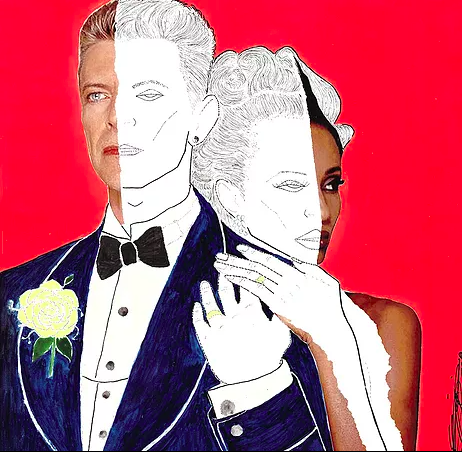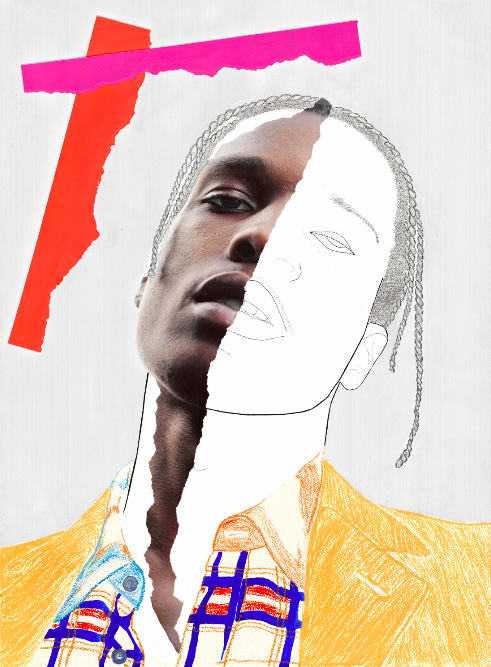Michelangelo, Virgil Abloh & The Royal Family: Artist Emmanuel Unaji on his biggest cultural influences
Emmanuel Unaji at The Hari London.
Art and the digital era.
What is the social impact of living in a world so often digitized, dehumanized and impersonal?
London-based British Nigerian artist and 1st class Fine Art graduate, Emmanuel Unaji, explores these questions, sometimes provoking uncomfortable rumination.
Unaji’s art practice is multi-faceted, often evoking thought and consideration for the unseen world behind pop culture, combining heritage, cultural subversion and commerciality into each piece of work he creates. Unaji is an alchemist: anything he touches in the world of fashion and art turns to gold.
A purveyor of art who combines painting, drawing, collage and fashion design, Unaji’s work is rebellious, bold and speaks of the artist’s narrative of the world he navigates within himself.
We asked the artist about his favourite art, how Louis Vuitton’s Virgil Abloh’s artistic streetwear has inspired him, and how the nuances of the digital era have influenced some of his greatest artworks.
Tell us what inspires you to create.
“I grew up travelling a lot, my grandfather and parents were avid travellers. When I was about 10 or 11, I visited the Vatican, and I think it was seeing the Sistine Chapel and the works of artists like Leonardo Da Vinci and Michelangelo, that proved to be such pivotal moments in my career trajectory. Understanding European art and its depth in historical context was something I wanted to fully immerse myself in. Later on in life, seeing Virgil Abloh (Creative Director for Louis Vuitton Menswear) using a juxtaposition of European art and streetwear in his designs, really activated something in me that made me want to pursue art and fashion.”
When did you create a piece of art for the first time?
“I went to Chislehurst Sidcup Grammar school which had a really strong art department. I’d spend a lot of my time there after school, but an official piece? That was in 2016 - an A1 collage which was a reflection on self-image and consumption.”
What have you been working on recently?
“A lot, a lot. I’m currently in residence at The Hari London where I have a few of my artworks on display, I’ve got a concept store in Boxpark for my fashion label, Unaji&co, plus I’ll be a part of an exhibition at London-based art gallery, D Contemporary, from 11th October – 17th October called ‘100 Years of Justice’. There’s a mural on diversity, race and British culture that I’ve been approached to work on by a large bank in the works but this will be under wraps until the time is right.”
You mentioned in GQ a piece of advice your mum gave you: “If you’re going to do this art thing, know the business inside out.” Has that advice served you well?
“Her advice was great: observing the art world from a financial standpoint has been incredibly beneficial for me. Andy Warhol got it right when he said, “Good art is good business”. I feel like time spent in the studio and talking to the press or attending events and gallery shows is just as much a part of my practice as creating is. As much as it is about the art, it’s also about the art of business. I have three pillars of success: your mission, your vision and your values which all play a major part in my practice.”
You’ve also created a few controversial pieces in your time as an artist…
“Yeah, I think my Harry and Meghan piece can make people feel a bit uncomfortable. Every piece of mine has a life of its own. This particular artwork will feature in an upcoming solo exhibition in Mayfair in the near future.”
Tell me a bit about the piece and what it means to you.
“For me, it’s a representation of the hierarchical structures within the monarchy and general public, and how we, from the African diaspora, navigate around that. It also represents the unspoken class and status divide among us which I find very apparent in the art world as well.”
Emmanuel at The Hari London wearing a blazer by Unaji&co. in collaboration with Velsvoir. Photography by Alexander Massek.
How much of you is in your artwork?
“During my modelling career, I really noticed the manufacturing of media, how it’s manipulated and how it’s presented for interpretation. The fragmentation that you see in my work is a representation of what you see and what you don’t see. But behind all of that is your soul.”
What do you want people to know about you?
“I want people to approach me and my art with a willingness to understand; with an openness. Art is a performance to me. It’s a very coded visual language left to interpretation. You don’t have to like it but observe with an open mind. I’m planning on doing a solo show in 2022. This will be more of a personal project for me on the theme of projecting oneself on social media and websites. All social output. The show will be personal and reflect my cultural heritage in a subversive way, tell of my experience of being a black body within a white gallery space. I’ll let viewers have their own interpretation of the show. Right now, every exhibition, every artwork is a proverbial breadcrumb that will ultimately converge to form a full picture at this solo show.”
Expand on being a British Nigerian in a white space.
“If you think about Africans in the diaspora and travelling over from their home countries and existing in European areas, we navigate that space how we best see fit. The concept of navigation is always present. I think that’s a central point. We like to use art and fashion as a performance. My streetwear line features pieces of my art on the backs of bomber jackets and I see that as a piece of a puzzle, encouraging you to follow the rabbit down the hole.“
What is the most valuable item you own?
Hands down my MacBook or my phone.
You’re jetting off to somewhere new: where’s it going to be?
Either Lille or Paris.
Discover Emmanuel’s art from a closer distance at The Hari London in Mayfair from June 24 - November 1 or explore his concept store in Boxpark in Shoreditch or further afield at Acid Gallery in Lille.




















Discover Europe's top beach clubs of summer 2025—from Marbella and Capri to Montenegro and Mykonos. Stylish seaside escapes offering dining, cocktails, music, and sun-soaked luxury—perfect summer getaways.